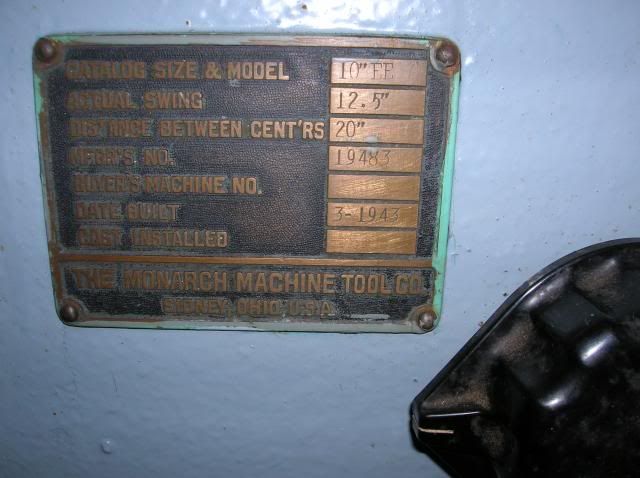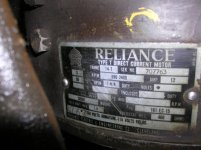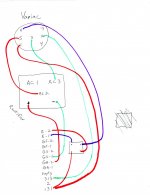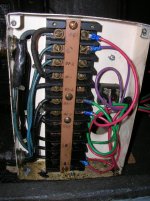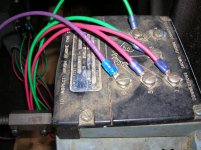I recently purchased a 1943 round dial, serial #19483. I really had to decide if I was taking on more than I should with this lathe. I was only largely unsure of my skill with the mechanicals, infinitely unsure of the electrics. I didn’t pay a great amount for it so I took the gamble. I started reading the first post from the Monarch forum dated January 10, 2001, and worked my way forward in time to the present. I started a Word file and every post that seemed relevant; I put the link in my file. I didn’t see any retrofit drive that looked like mine. So what do I have? (see photo album) It does run on 220 volt single phase. The owner started it up and the spindle ran forward and reverse, the feeds worked, but most of my attention was on the fireworks show coming from the brushes on the DC motor. And the smell took me back to my childhood, running HO trains and HO cars. He didn’t take the speed up too far and I was glad he shut it down. It did change speeds with either the lathe speed change knob, or the black knob next to the data plate.
It does have a few good points going for it. Long cross-feed slide with dovetail, taper attachment, bottom half of the carriage multiple length micrometer stop, Aloris AXA–T tool post, I’ve never seen a one sided post, it even has the tailstock dauber. It also came with a 6” 3 jaw and 8” 4 jaw chucks, a face plate, and the Monarch operators manual, although for an earlier lathe. I’ve never seen another spindle lock handle like is on my tailstock. Is that just a convenient replacement?
I have a ton of questions. The major two are:
Is this drive a good way to run the lathe?
Is the rest of the lathe in good enough condition to put money and time into it if it needs a new drive?
My ham handed tests show a bed, (or maybe saddle), with almost .003” wear, and I’m still playing with a spindle check. Someone has been in the spindle before judging by the buggered SKF lock nut, (I’m looking at the manual hoping I’m getting the names right). I’m guessing before it got the baby blue paint job it was pretty rough looking. But there are signs of hope. The tailstock had about .160” of play working the handwheel. I took it apart and it had been repaired badly at the spindle nut-lock nut. A little fiddling and it’s now .018”. I’m hoping some other slop in other assemblies may be able to be fiddled out. Going through other posts it seems even well worn lathes are still very good lathes and I wouldn’t mind that.
Below is the lathe and the link is to an album with all my EE pictures of the lathe. From the delivery, to putting it to bed for the winter in my barn. My shop has a wooden floor that is not up to the task of supporting the lathe. So I’ll have to wait until spring so I can sort that out. The pictures with the dial indicator are what happens when we get big temperature swings for a few days in the fall and spring. I removed the rust with 4 ought steel wool and coated everything in grease. For now, it sleeps in the barn until spring.
Thanks for looking and any comments.
Jeff Ward
1943 Monarch 10EE Photos by rustorater | Photobucket
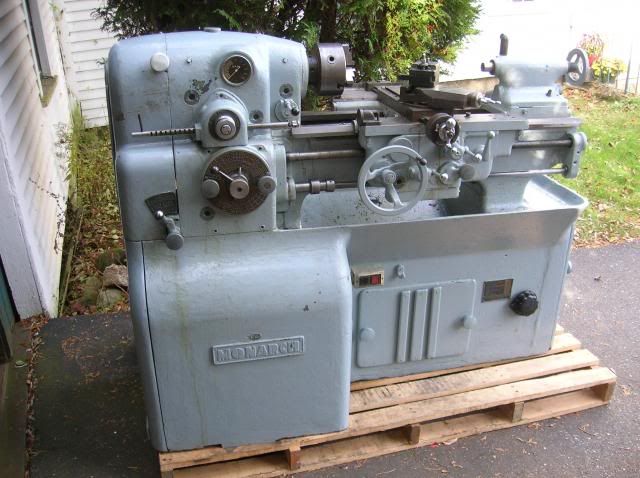
It does have a few good points going for it. Long cross-feed slide with dovetail, taper attachment, bottom half of the carriage multiple length micrometer stop, Aloris AXA–T tool post, I’ve never seen a one sided post, it even has the tailstock dauber. It also came with a 6” 3 jaw and 8” 4 jaw chucks, a face plate, and the Monarch operators manual, although for an earlier lathe. I’ve never seen another spindle lock handle like is on my tailstock. Is that just a convenient replacement?
I have a ton of questions. The major two are:
Is this drive a good way to run the lathe?
Is the rest of the lathe in good enough condition to put money and time into it if it needs a new drive?
My ham handed tests show a bed, (or maybe saddle), with almost .003” wear, and I’m still playing with a spindle check. Someone has been in the spindle before judging by the buggered SKF lock nut, (I’m looking at the manual hoping I’m getting the names right). I’m guessing before it got the baby blue paint job it was pretty rough looking. But there are signs of hope. The tailstock had about .160” of play working the handwheel. I took it apart and it had been repaired badly at the spindle nut-lock nut. A little fiddling and it’s now .018”. I’m hoping some other slop in other assemblies may be able to be fiddled out. Going through other posts it seems even well worn lathes are still very good lathes and I wouldn’t mind that.
Below is the lathe and the link is to an album with all my EE pictures of the lathe. From the delivery, to putting it to bed for the winter in my barn. My shop has a wooden floor that is not up to the task of supporting the lathe. So I’ll have to wait until spring so I can sort that out. The pictures with the dial indicator are what happens when we get big temperature swings for a few days in the fall and spring. I removed the rust with 4 ought steel wool and coated everything in grease. For now, it sleeps in the barn until spring.
Thanks for looking and any comments.
Jeff Ward
1943 Monarch 10EE Photos by rustorater | Photobucket






